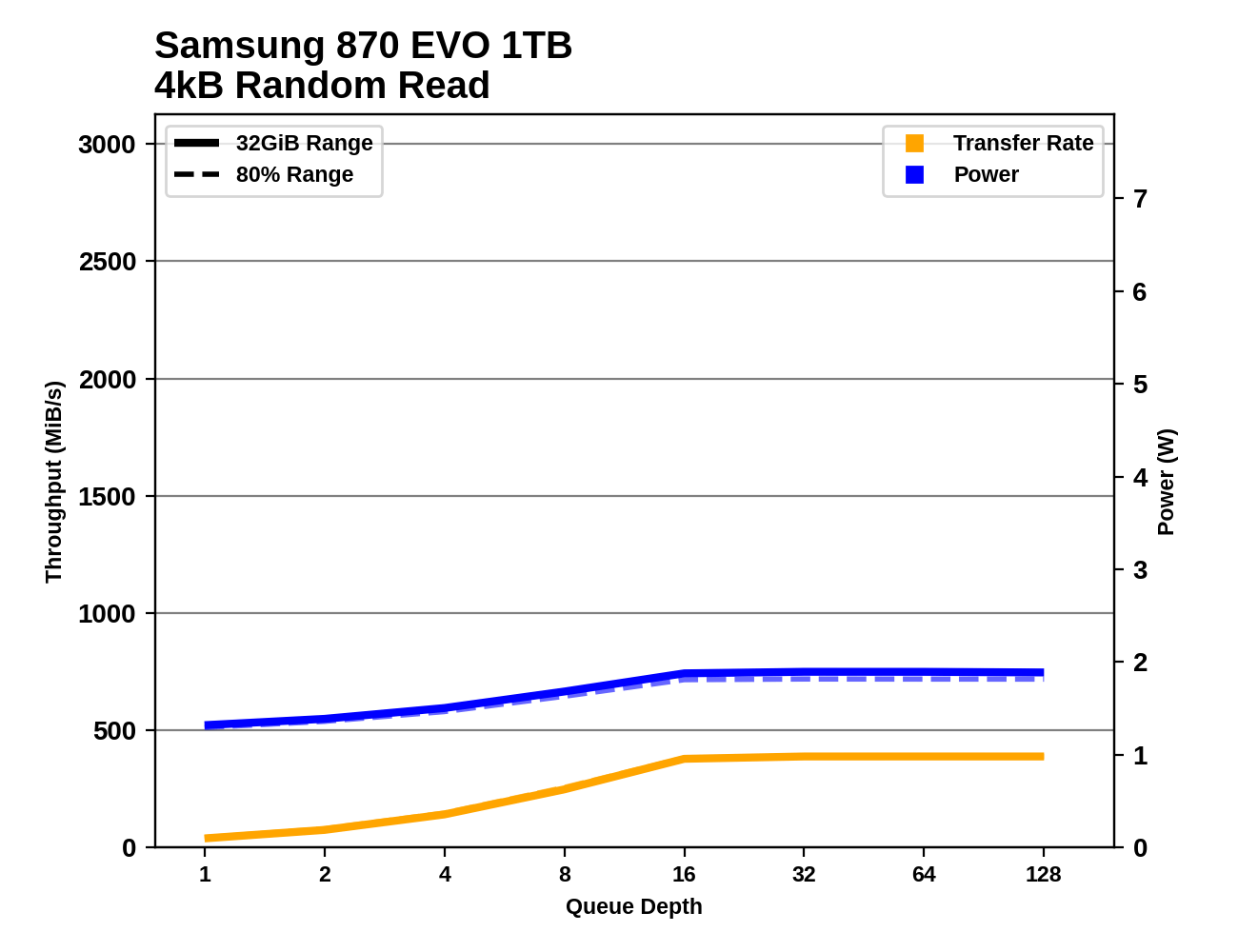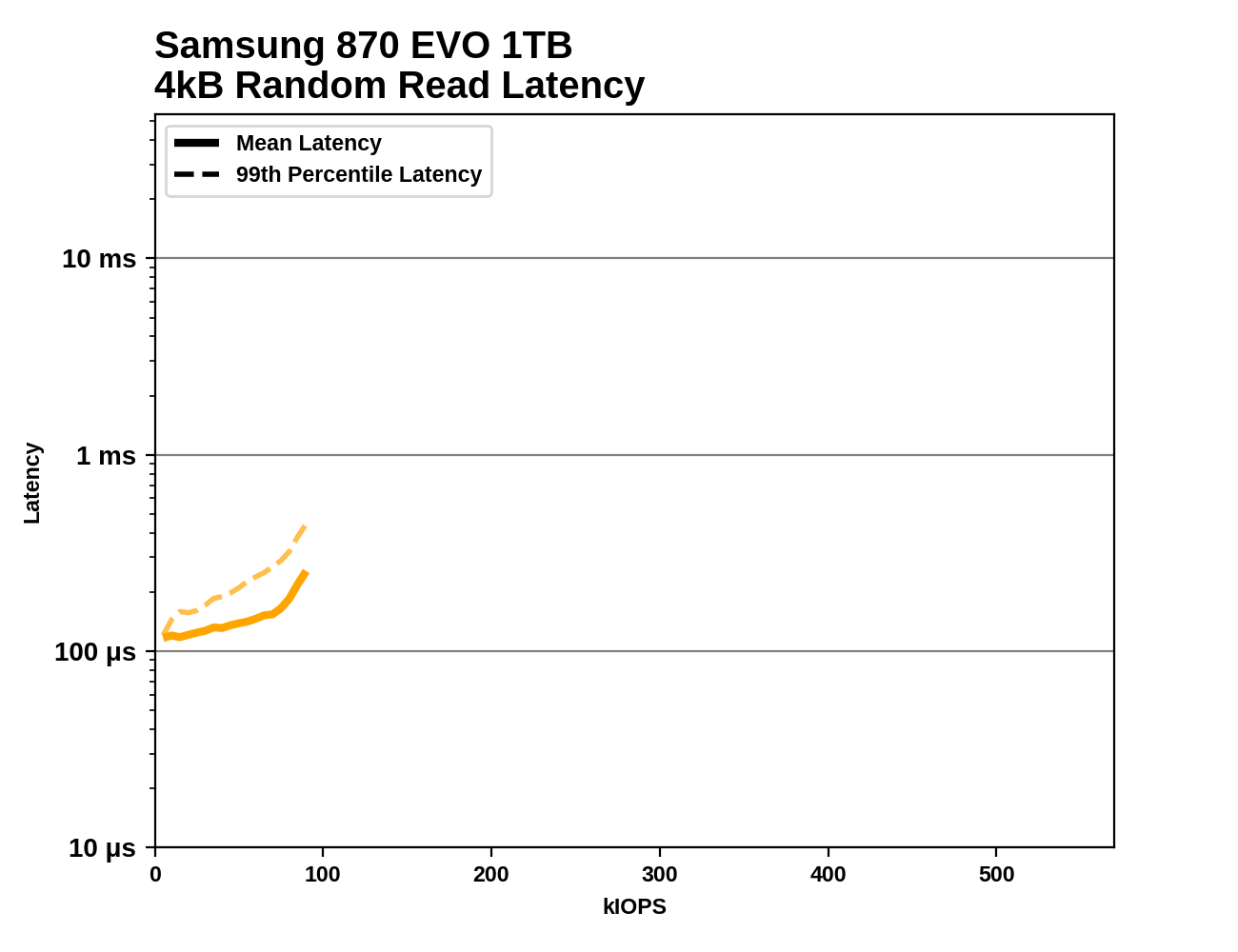The Samsung 870 EVO (1TB & 4TB) Review: Does the World Need Premium SATA SSDs?
by Billy Tallis on February 17, 2021 8:00 AM ESTBurst IO Performance
Our burst IO tests operate at queue depth 1 and perform several short data transfers interspersed with idle time. The random read and write tests consist of 32 bursts of up to 64MB each. The sequential read and write tests use eight bursts of up to 128MB each. For more details, please see the overview of our 2021 Consumer SSD Benchmark Suite.
 |
|||||||||
| Random Read | Random Write | ||||||||
| Sequential Read | Sequential Write | ||||||||
Our burst IO tests show little to no performance differences between the Samsung 870 EVO and other top SATA SSDs. The 1MB sequential transfers are already hitting the SATA throughput limits even at QD1, and the 4kB random IOs are at best marginally improved over Samsung's previous generation. Samsung's slight improvement to random read latency is enough to catch up to Micron's as shown by the Crucial MX500, but a 10% gain hardly matters when NVMe drives can double this performance.
Sustained IO Performance
Our sustained IO tests exercise a range of queue depths and transfer more data than the burst IO tests, but still have limits to keep the duration somewhat realistic. The primary scores we report are focused on the low queue depths that make up the bulk of consumer storage workloads. For more details, please see the overview of our 2021 Consumer SSD Benchmark Suite.
 |
|||||||||
| Random Read | Random Write | ||||||||
| Sequential Read | Sequential Write | ||||||||
On the longer synthetic tests that bring in some slightly higher queue depths, the improved random read performance of the 870 EVO is a bit more clear. In one sense it is impressive to see Samsung squeeze a bit more performance out of the same SATA bottleneck, but we're still talking about small incremental refinements where NVMe enables drastic improvements. Aside from random reads, the 870 EVO's performance improvements are exceedingly minute and it should be considered essentially tied with most other recent mainstream TLC SATA drives.
 |
|||||||||
| Random Read | Random Write | ||||||||
| Sequential Read | Sequential Write | ||||||||
Power consumption is one area where Samsung could theoretically offer more significant improvements despite still being constrained by the same SATA interface, but the 870 EVO doesn't really deliver any meaningful improvements there. The 4TB model is consistently a bit less efficient than the 1TB model on account of having more memory to keep powered up, but when comparing the 1TB model against its predecessor and competing drives there's nothing particularly noteworthy about the 870 EVO. SK hynix's Gold S31 has a modest efficiency advantage for random IO while Samsung is technically the most efficient of these SATA drives for sequential IO.
 |
|||||||||
| Random Read | |||||||||
| Random Write | |||||||||
| Sequential Read | |||||||||
| Sequential Write | |||||||||
The queue depth scaling behavior of the 870 EVOs is almost identical to the 860 EVOs and still quite typical for mainstream SATA drives. For random reads the 870 EVOs saturate around QD16, while for random writes QD4 suffices. On the sequential IO tests there's only a small performance gain from QD1 to QD16, and the more interesting question is how stable performance is through the rest of the sequential tests. The 1TB 870 EVO seems to run out of SLC cache a bit earlier than the 860 EVO when the sequential write test is running on an 80% full drive, but the 4TB model has plenty of cache to finish out that test at full speed.
Random Read Performance Consistency
This test illustrates how drives with higher throughput don't always offer better IO latency and Quality of Service (QoS), and that latency often gets much worse when a drive is pushed to its limits. This test is more intense than real-world consumer workloads and the results can be a bit noisy, but large differences that show up clearly on a log scale plot are meaningful. For more details, please see the overview of our 2021 Consumer SSD Benchmark Suite.
 |
|||||||||
Consistent with most of our other read performance tests, the Samsung 870 EVO shows slightly better average and 99th percentile random read latencies than most of its SATA competition. Even some of the entry-level NVMe drives that can deliver higher random read throughput than is possible for the 870 EVO still have clearly higher latency across most or all of the throughput range that the 870 EVO can cover. A QLC-based or DRAMless TLC NVMe SSD can potentially offer far higher throughput than any SATA SSD, but clearly beating the 870 EVO on both throughput and latency requires stepping up to a more mainstream NVMe design with DRAM and TLC NAND.










136 Comments
View All Comments
Billy Tallis - Thursday, February 18, 2021 - link
I still occasionally use SATA SSDs as if they were floppies, since all of my desktops have hot-swap bays. But its becoming more common that I use M.2 NVMe SSDs in USB enclosures. Either solution is preferable to WiFi or gigE when transferring tens of GB or more.Kamen Rider Blade - Thursday, February 18, 2021 - link
Not every machine is going to be connected locally on your own network.Not every machine will even be online either.
Please don't comment for the rest of us.
Spunjji - Friday, February 19, 2021 - link
M.2 in a USB 3.2 / Thunderbolt caddySorted
CaptainChaos - Wednesday, February 17, 2021 - link
How many grannies or grandpas need more than what SATA offers in the machines they use to go online for email, Facebook, or Amazon? Even if they stream videos their systems are ok using hardware a couple steps behind state of the art! SATA will linger for several more years.Oxford Guy - Friday, February 19, 2021 - link
640K ought to be enough for anyone.lmcd - Wednesday, February 17, 2021 - link
The thing that gets me is that just because a drive is U.2 doesn't mean it has to be a full 2.5in drive. Could easily do a "half size" or some random thing.Silver5urfer - Wednesday, February 17, 2021 - link
Yes the world needs a SATA SSD lol.NVMe drives are tooo damn hot. I don't know how long they will run like that, I've been running SATA without any ventilation on my notebook machine and use MLC drive for games and it's fantastic. Reliable doesn't overheat or has BS driver things esp for Win7 or such.
I thank Samsung for at-least doing this, I hope they put out a damn MLC with 4TB as well and do an 8TB 870 EVO update. As for SATA it's a reliable technology and has numerous advantages over the stupid PCIe lane limit, bandwidth, heat, dependable TBW.
lmcd - Wednesday, February 17, 2021 - link
There's a reason people are going wild over the SK Hynix P31. It's exactly what you need.Danvelopment - Wednesday, February 17, 2021 - link
SATA drives totally still make sense.Why?
Because there's only so much space on a motherboard, and every m.2 drive takes up quite a bit of it.
SATA allows you to redistribute drives within the case.
Maybe once hard drives are gone, then a new form factor can come out, 1" SATA or something. But cases will still be made with HDD form factors until they disappear, so might as well stick to that standard.
But they should do something about IOPS, design a drive destined to be SATA, with a controller that can knock out the full 600MBps with any load pattern, dump three or four times as many channels on it as an m.2, and they'll fly off the shelves.
Gigaplex - Wednesday, February 17, 2021 - link
Then you should be using U.2 instead of M.2.